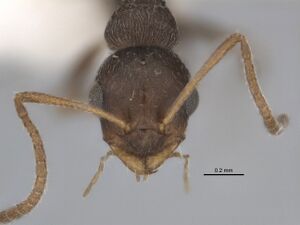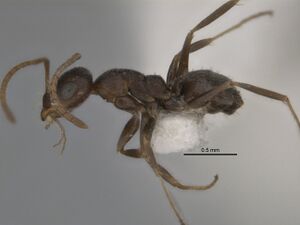Melophorus compactus
| Melophorus compactus | |
|---|---|

| |
| Scientific classification | |
| Kingdom: | Animalia |
| Phylum: | Arthropoda |
| Class: | Insecta |
| Order: | Hymenoptera |
| Family: | Formicidae |
| Subfamily: | Formicinae |
| Tribe: | Melophorini |
| Genus: | Melophorus |
| Species group: | biroi |
| Species complex: | biroi |
| Species: | M. compactus |
| Binomial name | |
| Melophorus compactus Heterick, Castalanelli & Shattuck, 2017 | |
A worker collected by Rev. Lowery in St George, QLD came from savannah woodland over black soil plain.
Identification
Heterick et al. (2017) - Melophorus compactus can be placed in the Melophoprus biroi species-group on the basis of characters of the clypeus, propodeum, mandible and palps. The species is also placed in the Melophorus mjobergi clade (within the Melophoprus biroi species-complex) because of characters best seen in the major worker. These include (seen in full-face view) the deeply recessed area around the frontal carinae and medial sector of clypeus visible in the major and media workers, the psammophore generally placed on or just above anterior margin of clypeus, and the minor workers hairy with bristly, short erect setae. Melophorus compactus can then be distinguished from Melophorus mjobergi and Melophorus postlei by the following characters: head of major worker without distinct sculpture and strongly shining, the setae-bearing sockets on head (if visible) appearing as tiny pits only, the sculpture also reduced on the head of media worker, which is moderately shining, in full-face view, the antennal carina of the major worker distinctly extended posteriad past the antennal insertion, the posterior extension of the carina straight, and the eye of the minor worker placed medially on the head capsule and large in size (in profile, eye length ≈ 0.40 × length of side of head capsule).
This rather uncommon species is distinguished from other members of the complex by its large eyes, reduced sculpture, the shining appearance of the head capsule without distinct pitting in the major worker, and the well-developed frontal carinae. Minor workers, however, closely resemble those of M. postlei, albeit the compound eye is much larger. This is the most southerly occurring member of the complex among those species with a recessed gena in the major and media worker.
Distribution
Melophorus compactus is known from a handful of collections in NSW and QLD.
Distribution based on Regional Taxon Lists
Australasian Region: Australia (type locality).
Distribution based on AntMaps
Distribution based on AntWeb specimens
Check data from AntWeb
Countries Occupied
| Number of countries occupied by this species based on AntWiki Regional Taxon Lists. In general, fewer countries occupied indicates a narrower range, while more countries indicates a more widespread species. |

|
Estimated Abundance
| Relative abundance based on number of AntMaps records per species (this species within the purple bar). Fewer records (to the left) indicates a less abundant/encountered species while more records (to the right) indicates more abundant/encountered species. |

|
Biology
Castes
Worker
   
| |
| . | |
Phylogeny
| Melophorus |
| ||||||||||||||||||||||||||||||||||||
Based on Heterick et al., 2017. Only selected species groups/complexes are included.
Nomenclature
The following information is derived from Barry Bolton's Online Catalogue of the Ants of the World.
- compactus. Melophorus compactus Heterick, Castalanelli & Shattuck, 2017: 172, fig. 33 (w.q.m.) AUSTRALIA.
Unless otherwise noted the text for the remainder of this section is reported from the publication that includes the original description.
Description
Worker
(n = 4): CI 98–107; EI 24–27; EL 0.14–0.22; HL 0.53–0.86; HW 0.52–0.92; ML 0.77–1.12; MTL 0.45–0.52; PpH 0.05–0.09; PpL 0.30–0.46; SI 65–129; SL 0.60–0.67.
Minor. Head. Head approximately oval with straight sides; posterior margin of head extended posteriad as a convex, sloping surface with a slight medioccipital protuberance; frons matt or with weak sheen, microreticulate or microreticulate-shagreenate; frons consisting exclusively or almost exclusively of well-spaced, appressed setae only (small, erect setae, if present, usually confined to ocular triangle or posterior margin of head). Eye moderate (eye length 0.20–0.49 length of side of head capsule); in full-face view, eyes set above midpoint of head capsule; in profile, eye set anteriad of midline of head capsule; eyes elliptical or slightly reniform. In fullface view, frontal carinae straight or weakly convex; frontal lobes straight in front of antennal insertion. Anteromedial clypeal margin narrowly convex and protruding, clypeal margin entire or very weakly indented, or narrowly convex and protruding anteromedially, clypeal midpoint distinctly notched; clypeal psammophore set at or just above anterior clypeal margin; palp formula 6,4. Four or five mandibular teeth in minor worker; mandibles triangular, weakly incurved; third mandibular tooth distinctly shorter than apical tooth and teeth numbers two and four; masticatory margin of mandibles approximately vertical or weakly oblique. Mesosoma. Integument of pronotum, mesonotum and mesopleuron with weak to moderate sheen, shagreenate on pronotum and dorsum of mesonotum, otherwise microreticulate; anterior mesosoma in profile broadly convex; erect pronotal setae absent; in profile, metanotal groove deep, ‘V’-shaped; propodeum shining and shagreenate; propodeum smoothly rounded or with indistinct angle, or uniformly flattened along an oblique trajectory; propodeal dorsum and declivity confluent; erect propodeal setae always absent; appressed propodeal setulae long and closely aligned, creating pubescence, or long, each reaching setae behind and in front, but not forming pubescence; propodeal spiracle situated on or beside declivitous face of propodeum, and shorter (length < 0.50 × height of propodeum). Petiole. In profile, petiolar node rectangular, vertex blunt, directed posteriad; in full-face view, shape of petiolar node uniformly rounded; node shining and smooth with vestigial sculpture. Gaster. Gaster shining, shagreenate (‘LP record’ appearance); pilosity of first gastral tergite consisting of well-spaced, long, whitish, appressed setae only, erect setae always absent. General characters. Colour reddish-brown with brown gaster through to concolorous chocolate.
Major. Head. Head quadrate (i.e., heart-shaped); posterior margin of head weakly concave; cuticle of frons matt or with weak sheen, microreticulate; pilosity of frons a mixture of a few well-spaced, erect setae interspersed with appressed setae only, or consisting exclusively or almost exclusively of well-spaced, appressed setae only (small, erect setae, if present, usually confined to ocular triangle or posterior margin of head). Eye small (eye length less than 0.2 × length of head capsule); in full-face view, eyes set above midpoint of head capsule; in profile, eye set anteriad of midline of head capsule; eyes elliptical. In full-face view, frontal carinae straight or weakly convex; frontal lobes straight in front of antennal insertion. Anterior clypeal margin narrowly convex and protruding anteromedially, clypeal margin entire or weakly indented; clypeal psammophore set at or just above anterior clypeal margin; palp formula 6,4. Four mandibular teeth in major worker; mandibles triangular, weakly incurved; third mandibular tooth distinctly shorter than apical tooth and teeth numbers two and four; masticatory margin of mandibles approximately aligned vertically or weakly oblique. Mesosoma. Integument of pronotum, mesonotum and mesopleuron with weak to moderate sheen, shagreenate on pronotum and dorsum of mesonotum, otherwise microreticulate; anterior mesosoma in profile broadly convex; erect pronotal setae short and unmodified, or weakly expanded distally; in profile, metanotal groove shallow, broadly V- or U-shaped; propodeum matt or with a weak sheen and microreticulate; propodeum smoothly rounded or with indistinct angle, or uniformly flattened along an oblique trajectory; propodeal dorsum and declivity confluent; erect propodeal setae absent; appressed propodeal setae long and closely aligned, creating pubescence, or long and separated by at least own length; propodeal spiracle situated on or beside declivitous face of propodeum, and shorter (length less than 0.50 × height of propodeum). Petiole. In profile, petiolar node squamiform; in full-face view, shape of petiolar node uniformly rounded; node shining and faintly shagreenate-microreticulate. Gaster. Gaster shining, shagreenate (‘LP record’ appearance); pilosity of first gastral tergite consisting of well-spaced, erect and semi-erect setae interspersed with regularly spaced appressed setae. General characters. Colour from medium brown with darker gaster to blackish-crimson.
Type Material
Holotype minor worker (top ant) from St George (‘Saint George’-sic), Queensland, 18 January 1966, B.B. Lowery, on black soil and savannah woodland, R 63 [ANIC32-900088] (Australian National Insect Collection). Paratypes: 2 minor workers on same pin and with same details as holotype (ANIC); 3 media workers and minor worker from St George (‘Saint George’-sic), Queensland, 18 January 1966, B.B. Lowery, [ANIC32-900169] (Museum of Comparative Zoology); 2 minor workers, 4 media workers, a major worker, a dealate queen and a male from St George (‘Saint George’-sic), Queensland, 18 January 1966, B.B. Lowery, [ANIC32-900089] (Queensland Museum).
Etymology
Latin compactus (‘thick’); adjective in the nominative singular.

